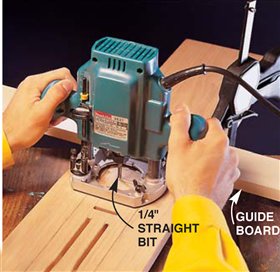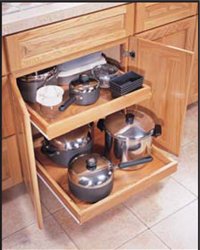We may receive a commission when you use our affiliate links. However, this does not impact our recommendations.
Weekend Kitchen Projects
Here are three ways to improve storage space in any kitchen.
You can whip through each project in an afternoon, using only
a tablesaw and a plunge router.
Countertop Knife RackStore up to nine knives in a handy rack that puts Install a knife-blade shield under the counter Fig. A: Knife Rack Layout
Fig. B: Knife Blade Shield
|
Click on any image to view a larger version. Store knives within easy reach! 1. Mark the rack’s outline and the knife slot 2. Cut the knife slots with a plunge router. 3. Cut an opening in your countertop with a 4. Fasten a blade shield to the back of |
Sink Cabinet ShelfIt’s easy to customize this catchall shelf to fit your You can mount this shelf on a cabinet door Note: If you have small Cutting ListHardware |
Keep cleaning supplies at your fingertips! 1. Cut two pairs of 3/4-in.-wide, 1/4-in.-deep 2. Slip the shelves into their dadoes. First drill 3. Fasten the rails to the front of the shelves 4. Clamp and screw the |
Roll-Out Kitchen TraysTrays on wheels put all the pots and pans in a Cutting ListHardwareSource(Note: Source information may have changed since the original publication date.) Woodcraft, woodcraft.com, 800-225-1153, Blum 230 Series 22" Drawer Slides, #01V10 This story originally appeared in American Woodworker February 2001, Issue #85. |
Reach that stuff in the back! 1. Mark the dadoes on one wide hardwood 2. Cut dadoes 1/4-in. deep, then rip the wide 3. Glue the vertical supports 4. Build the plywood trays |
Here are some supplies and tools we find essential in our everyday work around the shop. We may receive a commission from sales referred by our links; however, we have carefully selected these products for their usefulness and quality.






























